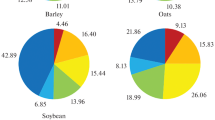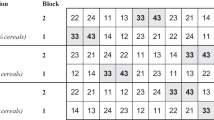Abstract
The plant biomass (postharvest and crop residues, green manure crops, etc.) actively used in Siberian agriculture partly contributes to the replenishment of mineral nutrients needed to sustain field crop yields and to maintain soil fertility. A comparative assessment of kinetic parameters for mineralization of manure, green manure crops (sweet clover, oilseed rape, and winter rye), and straw on the gray forest soil of the fallow arable land and their impact on productivity of fodder crops through their effects and aftereffects was performed. The observations for mineralization of nitrogenous substances in organic fertilizers showed that manure and biomass of high-protein crops (oilseed rape and sweet clover) have the greatest ability to mineralize nitrogen, while the crops with higher contents of carbon (winter rye and straw) have a lower capability to do it. Nitrate nitrogen as the preferred nitrogen source of plant nutrition is the dominant form of nitrogen according to the 3-year observations for the rates of mobile forms of mineral nitrogen in the gray forest soils during the land fallow process and beneath the crops. The results of the aggregate accounts for the crop yields for a year of crop-biomass effects and for 2 years of its aftereffects allowed us to ascertain almost the same impact of all the types of the organic biomass on the overall crop yield under the crop-rotation conditions. The only exception was the wheat-straw biomass, since the cycle of its decomposition in soil was not completed for 1 year of fallowing and three seasons beneath the crops.
Similar content being viewed by others
REFERENCES
Pershukevich, P.S. and Donchenko, A.S., Obespechenie prodovol’stvennoi bezopasnosti regionov Sibiri (Maintaining Food Security of Siberian Regions), Novosibirsk: Sib. Otd. Ross. Akad. Nauk, 2016.
Mezhregional'naya skhema razmeshcheniya i spetsializatsii sel’skokhozyaistvennogo proizvodstva v sub"ektakh Rossiiskoi Federatsii Sibirskogo federal’nogo okruga: Rekomendatsii (Interregional Scheme of Allocation and Specialization of Agricultural Production in the Constituent Entities of the Russian Federation of the Siberian Federal District: Recommendations), Novosibirsk: Sib. Otd. Ross. Akad. Nauk, 2016.
Berzin, A.M., Zelenye udobreniya v Srednei Sibiri (Green Fertilizers in Central Siberia), Krasnoyarsk: Krasnoyarsk. Gos. Agrar. Univ., 2002.
Sorokin, I.B., Organicheskoe veshchestvo v adaptivno-landshaftnykh sistemakh zemledeliya Tomskoi oblasti (Organic Matter in Adaptive-Landscape Systems of Agriculture in Tomsk Oblast), Tomsk, 2007.
Gamzikov, G.P., Agrokhimiya azota v agrotsenozakh (Agrochemistry of Nitrogen in Agrocenoses), Novosibirsk: Rossel’khozakad., Novosib. Gos. Agrar. Univ., 2013.
Zavalin, A.A., Chernova, L.S., Sapozhnikov, S.N., and Kovalenko, A.A., Consumption of soil nitrogen by plants under the application of a mineral fertilizer, green manure, and biopreparation (the study involves 15N), Russ. Agric. Sci., 2020, vol. 46, pp. 39–42.
Dospekhov, B.A., Metodika polevogo opyta (Methodology of Field Experiments), Moscow: Agropromizdat, 1985.
Voronina, L.V. and Gritsenko, A.G., Klimat i ekologiya Novosibirskoi oblasti (Climate and Ecology of Novosibirsk Oblast), Novosibirsk: SGGA, 2011.
Agrokhimicheskie metody issledovaniya pochv (Agrochemical Methods of Soil Research), Moscow: Nauka, 1975.
Slavnina, T.P., Azot v pochvakh elyuvial’nogo ryada (Nitrogen in Eluvial Soils), Tomsk: Tomsk. Gos. Univ., 1978.
Mal’tsev, V.T., Azotnye udobreniya v Priangar’e (Nitrogen Fertilizers in Angara Region), Novosibirsk: Rossel’khozakad., Irkutsk. NIISKh, 2001.
Gamzikov, G.P., Prakticheskie rekomendatsii po pochvennoi diagnostike azotnogo pitaniya polevykh kul’tur i primeneniyu azotnykh udobrenii v sibirskom zemledelii (Practical Recommendations for Soil Diagnostics of Nitrogen Nutrition of Field Crops and Use of Nitrogen Fertilizers in Siberian Agriculture), Moscow: Rosinformagrotekh, 1918.
Sharkov, I.N., The role of plant residues of grain crops in the regulation of soil fertility in Siberia, Biologicheskie istochniki elementov mineral’nogo pitaniya rastenii. III Sibirskie agrokhimicheskie Pryanishnikovskie chteniya: Mater. mezhd. nauch. konf. (Omsk, 12–16 iyulya 2005 g.) (Biological Sources of Elements of Mineral Nutrition of Plants. III Siberian Agrochemical Pryanishnikov readings: Proc. Int. Sci. Conf. (Omsk, July 12–16, 2005)), Novosibirsk: Rossel’khozakad., Sib. Otd., 2006, pp. 69–77.
Suleimenov, S.Z., Nitrogen-mobilizing capacity of soils in Western Siberia and Northern Kazakhstan, Extended Abstract of Cand. Sci. (Eng.) Dissertation, Novosibirsk: Novosibirsk State Agrarian University, 2009.
Praveen-Kumar, Jagadish, C.T., Jitednra, P., and Shyam, K., A rapid method for assessment of plant residue quality, J. Plant Nutr. Soil Sci., 2003, vol. 166, no. 5, pp. 662–666.
Author information
Authors and Affiliations
Corresponding author
Ethics declarations
The authors declare that they have no conflict of interest. This article does not contain any studies involving animals or human participants performed by any of the authors.
Additional information
Translated by O. Zhiryakova
About this article
Cite this article
Gamzikov, G.P., Suleimenov, S.Z. Effect of Plant Biomass on Gray Forest Soil’s Nitrogen Rate and Field Crop Productivity. Russ. Agricult. Sci. 46, 484–489 (2020). https://doi.org/10.3103/S1068367420050067
Received:
Accepted:
Published:
Issue Date:
DOI: https://doi.org/10.3103/S1068367420050067




